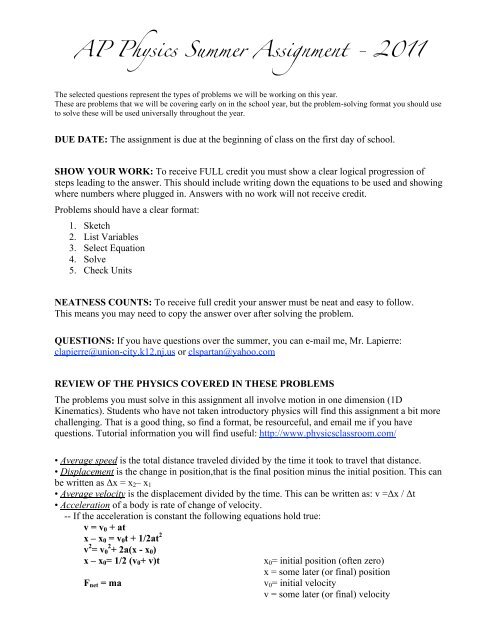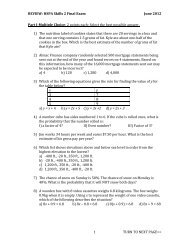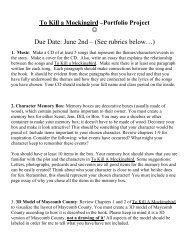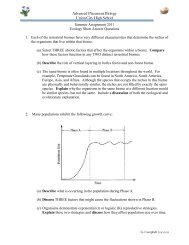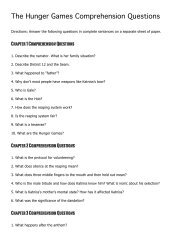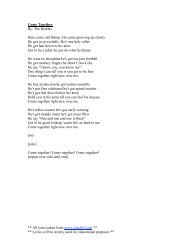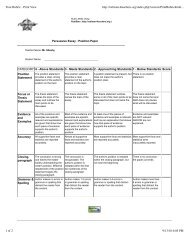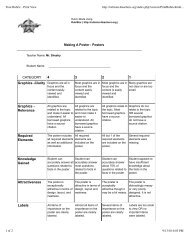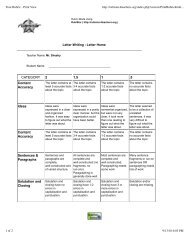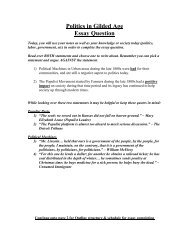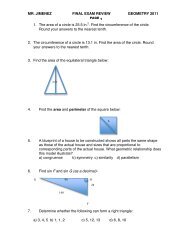AP Physics Summer Assignment - Union City High School
AP Physics Summer Assignment - Union City High School
AP Physics Summer Assignment - Union City High School
Create successful ePaper yourself
Turn your PDF publications into a flip-book with our unique Google optimized e-Paper software.
<strong>AP</strong> <strong>Physics</strong> <strong>Summer</strong> <strong>Assignment</strong> - 2011<br />
The selected questions represent the types of problems we will be working on this year.<br />
These are problems that we will be covering early on in the school year, but the problem-solving format you should use<br />
to solve these will be used universally throughout the year.<br />
DUE DATE: The assignment is due at the beginning of class on the first day of school.<br />
SHOW YOUR WORK: To receive FULL credit you must show a clear logical progression of<br />
steps leading to the answer. This should include writing down the equations to be used and showing<br />
where numbers where plugged in. Answers with no work will not receive credit.<br />
Problems should have a clear format:<br />
1. Sketch<br />
2. List Variables<br />
3. Select Equation<br />
4. Solve<br />
5. Check Units<br />
NEATNESS COUNTS: To receive full credit your answer must be neat and easy to follow.<br />
This means you may need to copy the answer over after solving the problem.<br />
QUESTIONS: If you have questions over the summer, you can e-mail me, Mr. Lapierre:<br />
clapierre@union-city.k12.nj.us or clspartan@yahoo.com<br />
REVIEW OF THE PHYSICS COVERED IN THESE PROBLEMS<br />
The problems you must solve in this assignment all involve motion in one dimension (1D<br />
Kinematics). Students who have not taken introductory physics will find this assignment a bit more<br />
challenging. That is a good thing, so find a format, be resourceful, and email me if you have<br />
questions. Tutorial information you will find useful: http://www.physicsclassroom.com/<br />
• Average speed is the total distance traveled divided by the time it took to travel that distance.<br />
• Displacement is the change in position,that is the final position minus the initial position. This can<br />
be written as Δx = x 2 – x 1<br />
• Average velocity is the displacement divided by the time. This can be written as: v =Δx / Δt<br />
• Acceleration of a body is rate of change of velocity.<br />
-- If the acceleration is constant the following equations hold true:<br />
v = v 0 + at<br />
x – x 0 = v 0 t + 1/2at 2<br />
v 2 = v 0 2 + 2a(x - x 0 )<br />
x – x 0 = 1/2 (v 0 + v)t<br />
F net = ma<br />
x 0 = initial position (often zero)<br />
x = some later (or final) position<br />
v 0 = initial velocity<br />
v = some later (or final) velocity
a = acceleration<br />
t = time interval; that is the time between x &<br />
x 0 and between v & v 0<br />
F net = net force<br />
m = mass (kg)<br />
PRE-PROBLEMS: Use your prior math knowledge and skills to complete the following before<br />
moving on to the <strong>Physics</strong> Problems.<br />
I. Simplifying Expressions & Addition of Polynomials<br />
a) −(x 2 − 2x + 5)<br />
b) 2y − (3y − 4)<br />
c) 6x − 2(3x − 6) + 8<br />
d) [7(x − 3) + 4] − [6(3x − 2) + x]<br />
e) (5x 2 − 2x −1) − (3x 2 − 5x + 7)<br />
f) (6x 3 − 4x 2 + x − 9) − (3x 2 + 7x + 3)<br />
II. Translating Phrases into Numerical Expressions<br />
a) Eighteen more than a number<br />
b) Five less than a number<br />
c) The product of a number and three<br />
d) The difference of a number and<br />
seven<br />
e) Three times the difference of a<br />
number and one<br />
f) Nine less than the product of a Twothirds<br />
of a number and two<br />
III. Solving Equations<br />
a) 3y −13y = 50<br />
b) 11b = 45 − 4b<br />
c) 4y + 2y - 7 = 3y +11<br />
d) 1 2 x + 1 3 x = 1 6 x − 5<br />
e) t 2 = −33<br />
IV. Solving Formulas<br />
a) V = lwh for w =_______<br />
b) y = mx + b for m =_______<br />
c) A = 2πb for π = _______<br />
d) A = ½ d 1 d 2 for d2 =_______<br />
e) y = kx/z for x = _______<br />
f) V=πb 2 h for b=_________<br />
V. Pythagorean Theorem<br />
If c is the measure of the hypotenuse of a right triangle, find each missing measure. Round answers to the nearest<br />
hundredth.<br />
a) a = 6, c = 10, b = ______<br />
b) a = 5, c = 13, b = ______<br />
c) b = 0.8, c = 1.0, a = _____<br />
d) b = 11, c = 289 , a = ______<br />
e) a = 19, b = 39 , c = ______<br />
f) a = 6 , b = 19 , c = ______
VI. Right Triangle Trigonometry
PROBLEMS: Use the tutorial website for help. It is very clearly organized and can help you<br />
tremendously!<br />
1. (One page) Starting from a pillar, you run 200 m east (the +X-direction) at an average speed of 4.0 m/s, then<br />
run 280 m west at an average speed of 7.0 m/s to a post. Calculate your<br />
a) average speed from pillar to post;<br />
b) average velocity from pillar to post. (be sure to sketch the problem)<br />
2. (One to two pages) At the instant a traffic light turns green, an automobile that has been waiting at an<br />
intersection starts ahead with a constant acceleration of 2.00 m/s 2 . At the same instant a truck, traveling with a<br />
constant speed of 18.0 m/s, overtakes and passes the automobile. (be sure to sketch the problem)<br />
a) How far beyond its starting point does the automobile overtake the truck?<br />
b) How fast is the automobile traveling when it overtakes the truck?<br />
c) On a single graph sketch the position of each vehicle as a function of time. Take x=0 at the intersection.<br />
3. (One page) On a twenty-mile bike ride, you ride the first ten miles at an average speed of 10 mi/h. What must<br />
your average speed be over the next ten miles to have your average speed for the total twenty miles be (be sure to<br />
sketch the problem)<br />
a) 5 mi/h<br />
b) 15 mi/h<br />
c) Given the average speed for the first ten miles, is it possible for you to attain an average speed of 20 mi/h for<br />
the total twenty-mile ride? Why or why not?<br />
4. (One page) A spacecraft of mass m =1.05x10 4 kg in interplanetary space is acted on by a force vector<br />
F=1.0x10 5 N in the direction of Polaris, the North Star. Determine the magnitude and direction of the acceleration<br />
vector.<br />
5. (One Page)A person who weighs 800 N steps onto a scale that is on the floor of an elevator. If<br />
the elevator accelerates upward at a rate of 5 m/s2, what will the scale read? Include a freebody<br />
diagram in your analysis<br />
6. (Five pages) Take a picture (a real picture, not something off the web) of something that demonstrates an<br />
aspect of one of the five core areas to be studied this year. 1) Attach the picture to a sheet of paper (or print it) and<br />
2) explain how it shows the area of study and 3) clearly define the area of study.<br />
A) Mechanics (35% of exam)<br />
B) Fluids and Thermodynamics (15% of exam)<br />
C) Waves and Optics (15% of exam)<br />
D) Electricity and Magnetism (25%)<br />
E) Modern <strong>Physics</strong> (10%)<br />
7. (One page typed MINIMUM) Read and comment on “Déjà vu” article
Déjà vu<br />
In the fall of 2003, I had the opportunity to attend and <strong>AP</strong> <strong>Physics</strong> workshop given by Josh Schulman. Mr. Schulman<br />
distributed the following handout and to my amazement, he had documented my exact philosophies and views concerning the<br />
approach to teaching and learning physics. He distributes the handout at the beginning of the year so students will have a<br />
better grasp of how to set priorities and approach the class.<br />
I highly recommend you save this handout and keep it in the front of your notebook. Invest the time to read it several times to<br />
be come familiar with it contents. You may find it necessary to review it when you begin to feel stressed out and<br />
overwhelmed.<br />
One element for doing well in any class is to try to identify and develop an appreciation of what the teacher considers<br />
important. In this handout Mr. Schulman has clearly identified what is important to me, your teacher, so you, my student,<br />
should try to take to heart the advice that is being offered.<br />
How to Approach your <strong>Physics</strong> Course<br />
Or, Seven Things My Students Know in June that I Wish They Had Known the<br />
Previous September 1<br />
<strong>Physics</strong> has a poor reputation. I know this from experience: strange people are often asking what I<br />
do for a living, so I tell them “I teach high school physics.” Nine times out of ten, the strange<br />
person’s response is, “Eww. I hated physics.” I have grown to realize that what these strange<br />
people hated was not physics, itself. Rather, they hated their experience learning physics.<br />
What I try to teach my students is not simply the theory and application of physics. Instead, I try to<br />
teach them how to approach the process of problem‐ 1 solving, how to think like a scientist. <strong>Physics</strong><br />
is just the medium through which I choose to communicate these abstract lessons in thinking. The<br />
students who wrote this book figured out my pedagogic motives early on, and as a result, each<br />
found his first physics course to be a decisively positive experience.<br />
This doesn’t mean there weren’t struggles, frustrations, times when problems seemed hopeless. I<br />
suggest that any worthwhile endeavor involves some sort of tribulation. (For example, I don’t<br />
know any actor who doesn’t curse tech rehearsals the week before the performance of a play; yet<br />
not one of these actors would consider giving up the stage because of the difficulty of these<br />
unbearable rehearsals.) When I look back on physics class, it is the good times, the camaraderie,<br />
the “eureka!” moments that I remember.<br />
It usually takes one to two months for physics students to get the hang of the class. It is in this<br />
initial portion of the school year that most of the frustration occurs. Every year I find myself<br />
wishing that my new students knew some fundamental, inalienable truths about how to approach<br />
a physics course. Of course, I understand that some of these things can only be learned by<br />
experience. But here’s my list of instructions. Read them, try to take them to heart, and maybe at<br />
the end of the year you’ll see what I was talking about.<br />
I. Ignore your grade.<br />
This seems to be the most ridiculous statement you’ve ever read. You probably are asking, “Are<br />
you sure you’re a teacher?” But this may be the most important of these here ten suggestions. You<br />
should not ask yourself or your teacher “How could I have gotten more points on this<br />
assignment?” or “Are you going to grade this?” You’ll worry so much about giving the teacher<br />
merely what she wants that you won’t learn physics in the way that’s best for you. Rather, whether<br />
1 From Five Steps to a 5: <strong>AP</strong> physics by Josh Schulman and Greg Jacobs, pending publication, McGraw-<br />
Hill Companies, Inc. Reproduced with the permission of Greg Jacobs.
your score is perfect or near zero, ask, “did I really understand all aspects of these problems?”<br />
Remember, the <strong>AP</strong> exam tests your physics knowledge. If you understand physics thoroughly, you<br />
will have no trouble at all on the <strong>AP</strong>. But while you may be able to argue yourself a better grade in<br />
your physics class even if your comprehension is poor, the <strong>AP</strong> graders are not so easily moved.<br />
If you take my advice, if you really, truly ignore your grade and focus on physics, your grade will<br />
come out in the wash – you’ll find that you got a very good grade after all, because you understood<br />
the subject so well. But you won’t care, because you’re not worried about your grade!<br />
II. Don’t bang your head against a brick wall.<br />
My meaning here is figurative, not literal. 2 Never spend more than 10 minutes or so staring at a<br />
problem without getting somewhere. If you honestly have no idea what to do at some stage of a<br />
problem, STOP. Put the problem away. <strong>Physics</strong> has a way of becoming clearer after you take a<br />
break.<br />
On the same note, if you’re stuck on some algebra, don’t spend forever trying to find what you<br />
know is a piddly mistake, say a missing negative sign or something. Put the problem away, come<br />
back in an hour, and start from scratch.<br />
This will save you time in the long run.<br />
And finally, if you’ve put forth a real effort, you’ve come back to the problem many times, and you<br />
can’t get it: relax. Ask the teacher for the solution, and allow yourself to be enlightened. You will<br />
not get a perfect score on every problem. But you don’t care about your score, remember?<br />
III. Work with other people.<br />
When you put are struggling with a problem, it always helps to discuss that problem with others.<br />
Form study groups; have a buddy in class with whom you are consistently comparing solutions.<br />
Though you may be able to do all your work in every other class without help, there is no student<br />
I have ever met who is capable of solving most physics problems completely on his or her own. It<br />
is not shameful to ask for help. Nor is it dishonest to seek assistance – as long as you’re not<br />
copying, or allowing a friend to carry you through the course, group study is permitted and<br />
encouraged in virtually 2 every physics class around the globe.<br />
IV. Ask questions when appropriate.<br />
I know that physics teachers have a reputation as mean or unapproachable; but in reality, we very<br />
much want to help you understand our subject. If you don’t understand something, don’t be afraid<br />
to ask. Chances are that the rest of the class has the same question. If your question is too basic, or<br />
if the teacher can’t spend the class time to answer, he’ll tell you so. Sometimes the teacher will not<br />
answer you directly, but will give you a hint, something to think about so that you might guide<br />
yourself to your own answer. Don’t interpret this as refusing to answer your question. You must<br />
learn to think for yourself, and your teacher is helping you develop the analysis skills you need for<br />
success in physics.<br />
2 Though there are benefits to taking this advice literally, as well.
V. Keep an even temper.<br />
A football team should not give up because they allow an early field goal.<br />
Similarly, you should not get upset at poor performance on a test or problem set.<br />
No one expects you to be perfect. Learn from your mistakes, and move on – it’s too long a school<br />
year to let a single physics assignment affect your emotional state.<br />
On the same note, though, a football team should not celebrate victory because it scores an early<br />
touchdown. You might have done well on this test, but there’s the rest of a nine month course to<br />
go. Congratulate yourself, then concentrate on the next assignment.<br />
VI. Don’t Cram.<br />
Yes, I know that you got an “A” on your history final because, after you slept through class all<br />
semester, you studied for 15 straight hours the day before the test and learned everything. And<br />
yes, I know you are willing to do the same thing this year for physics. I shall warn you, both from<br />
my and from others’ experience: it won’t work. <strong>Physics</strong> is not about memorization and<br />
regurgitation.<br />
True, there are some equations you need to memorize. But problem‐solving skills cannot be<br />
learned overnight.<br />
Furthermore, physics is cumulative. The topics you discuss in December rely on the principles you<br />
learned in September. If you don’t understand basic vector analysis and force diagrams (a.k.a. free<br />
body diagrams), how can you understand the relationship between an electric field (which is a<br />
vector quantity) and an electric force? Or the multitude of other vector quantities, which you will<br />
eventually study?<br />
So, the answer is to keep up with the course. Spend some time on physics every night, even if that<br />
time is only a couple minutes, even if you have no assignment due the next day. Spread your “cram<br />
time” over the entire semester. The night before a major exam, I have always told my students not<br />
to study after 5 or 6 P.M. If they have done all the homework, understood all the quizzes, and gone<br />
over what they missed on minor tests, they will do fine on the big one. This is why my classes have<br />
a wild 3 party each year on the eve of the <strong>AP</strong> exam. 3<br />
VII. Never forget: <strong>Physics</strong> is Phun!<br />
The purpose of all these problems, these equations, the exams, is to gain a knowledge of physics, a<br />
deeper understanding of how the natural world works.<br />
Don’t be so caught up in the grind of your coursework that you fail to say “Wow!” occasionally.<br />
Some of the things you’re learning are truly amazing. <strong>Physics</strong> gives insight into some of<br />
humankind’s most critical discoveries, our most powerful inventions, our most fundamental<br />
technologies. Enjoy yourself. You have an opportunity to emerge from your physics course with<br />
wonderful and useful knowledge, and unparalleled intellectual insight. Do it.<br />
3 Defined as “involving copious amounts of pizza and highly-caffeinated soda.”


